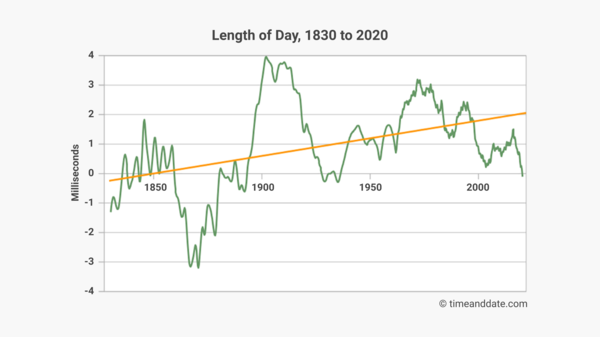What Is a Negative Leap Second?
Sometime in the future, our clocks may need a negative leap second to keep up with the spinning Earth.
UPDATE: The End of Leap Seconds?
In November 2022, the General Conference on Weights and Measures (CGPM)—an international body that decides on global standards for how things are measured—passed a resolution asking the International Telecommunication Union (ITU) to consider changing the way we define civil time. Read the full story.

The complex motion of the oceans, the atmosphere, and the Earth's molten core makes our planet's rotation unpredictable.
©iStockphoto.com/JNEphotos
A negative leap second is a second that is subtracted from our clocks to keep them in sync with the Earth's rotation. It is the opposite of a positive leap second, which is a one-second addition to our clocks.
The system of leap seconds was introduced in the early 1970s. So far, there have been 27 positive leap seconds, but no negative leap seconds. This is because, in the last few decades, the Earth's rotation has generally been a bit slow.
In recent years, however, the Earth's rotation has been faster. If this trend continues, we may require a negative leap second at some point in the future.
A Minute with 59 Seconds
The International Earth Rotation and Reference Systems Service (IERS) monitors the Earth's rotation, and takes decisions on when to add or subtract a leap second.
The IERS aims to keep Coordinated Universal Time (UTC)—which is what our clocks use—within one second of Universal Time (UT), which is based on the Earth's rotation. UTC is linked to the super-steady beat of International Atomic Time (TAI).
If the Earth's spin gets too far ahead of our clocks, a second would be taken away from UTC. In practice, this negative leap second would mean our clocks skip a second, and advance from 23:59:58 straight to 00:00:00.
Traditionally, leap seconds occur on the last day of June or the last day of December.
Is the Earth Speeding Up or Slowing Down?
On average, the Earth takes 24 hours—one mean solar day—to complete one rotation with respect to the Sun. While this translates to 86,400 seconds on paper, the Earth's rotation is not constant, so most days are fractionally longer or shorter than that.
The following chart shows how the Earth's rotation varied between 1830 and 2020.
The green line indicates the difference, in milliseconds, between the Earth's rotation and 86,400 seconds. The orange line is the overall trend across the 190-year period.


Note: Although atomic clocks were not developed until the 1950s and 1960s, telescopic timings of lunar occultations—where the Moon passes in front of a star—provide us with information about the Earth's rotation going back to the 17th century.
The orange trend line shows that, over the course of a century, the Earth's rotation is gradually slowing. This is a result of tidal friction caused by the Moon. For instance, the twice-daily sloshing of the ocean tides takes away a tiny part of the Earth's rotational energy.
On the other hand, the green line tells us that, over the course of a decade, the Earth's rotation is unpredictable. The reason for this is the complicated motion of—among other things—the Earth's oceans, atmosphere, and molten core.
In 2016, for instance, the Earth took 1.34 milliseconds longer, on average, than 86,400 seconds to complete one rotation. But across the whole of 2020, the Earth took a fraction of a millisecond less than 86,400 seconds to rotate once.
Planet Earth is an exceptionally accurate timekeeper
Will a Leap Second Be Needed Anytime Soon?
We don't know, because we don't fully understand the changes in the Earth's rotation that happen over the course of a decade or so.
Looking again at the chart above, if the green line continues downward—meaning the length of day continues to decrease—a negative leap second may be required at some stage.
If, however, the green line turns upward again soon—and at some point it will because, overall, the Earth is slowing—the next leap second will be positive.
Speaking of time “leaps:” Is time travel possible?
Why Are There No Negative Leap Days?
Leap days are always positive because the Earth consistently—within half an hour or so—takes about a quarter of a day longer than 365 days to go round the Sun. Over a four-year period, these quarter-days add up to a full extra day: February 29.
Just imagine, however, if the solar system was arranged so the Earth took a quarter of a day less than 365 days to go round the Sun. In this imaginary situation, we would have negative leap days, and our calendar would advance straight from February 27 to March 1 every four years.